Audemars Piguet Introduces the new Royal Oak Perpetual Calendar 150th Anniversary Edition, the final chapter for the masterpiece Calibre 5135.
As you may have seen already, Audemars Piguet is celebrating its 150th anniversary this year. As one of the three “holy trinity” brands in the world of horology, this is a momentous occasion not only for the brand itself but also for the world of watchmaking as a whole.
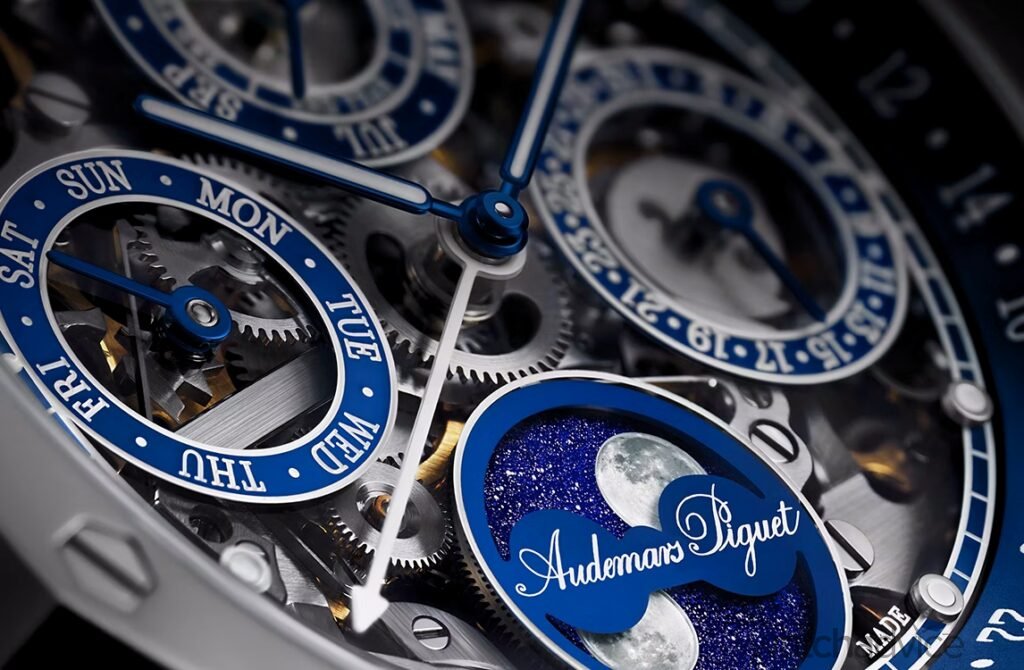
There are only a handful of brands that have been in continuous operation for the past 150 years. Audemars Piguet have brought a lot to watchmaking, with one of the relevant innovations for this instance being the Audemars Piguet Ref 5516, a timepiece that built upon Patek Philippe’s No.97975 perpetual calendar to become the first ever watch to display the leap year indicator on the dial.
Since 1875, Audemars Piguet has been preserving its rich heritage of innovation, craftsmanship, and avant-garde design. Arguably, the most iconic moment in the brand’s history (so far!) came with the introduction of the Royal Oak in 1972. The Royal Oak, Gerald Genta’s masterpiece, pioneered the industry as a luxury sports watch but later went on to push the boundaries of watchmaking again with the addition of groundbreaking complications.
Related Reading: The Legacy Of Iconic Watch Designs: Audemars Piguet Royal Oak – Part One
And this is where we are today. Last month, Audemars Piguet kicked off the 150th-anniversary celebrations by releasing a trio of perpetual calendar models, which included two references from the iconic Royal Oak line and a model from the brand’s newest collection: the Code 11.59. All three models bring something different to the table.
Related Reading: Audemars Piguet’s New Perpetual Calendar Is A Guaranteed Showstopper
Firstly, the two Royal Oak Perpetual models are presented in either steel with stunning blue grande tapisserie dial or 18k Sand gold with an 18k Sand gold grande tapisserie dial, reminiscent of the quite incredible 18k Sand Gold Royal Oak Flying Tourbillon Openworked released last year, which left me speechless. Then comes the Code 11.59, a timepiece that received some pushback upon its initial release (as expected) but is now quickly becoming a favourite among enthusiasts. This latest Code 11.59 was presented in an 18k white gold case, with a Blue fumé dial with signature AP embossing.

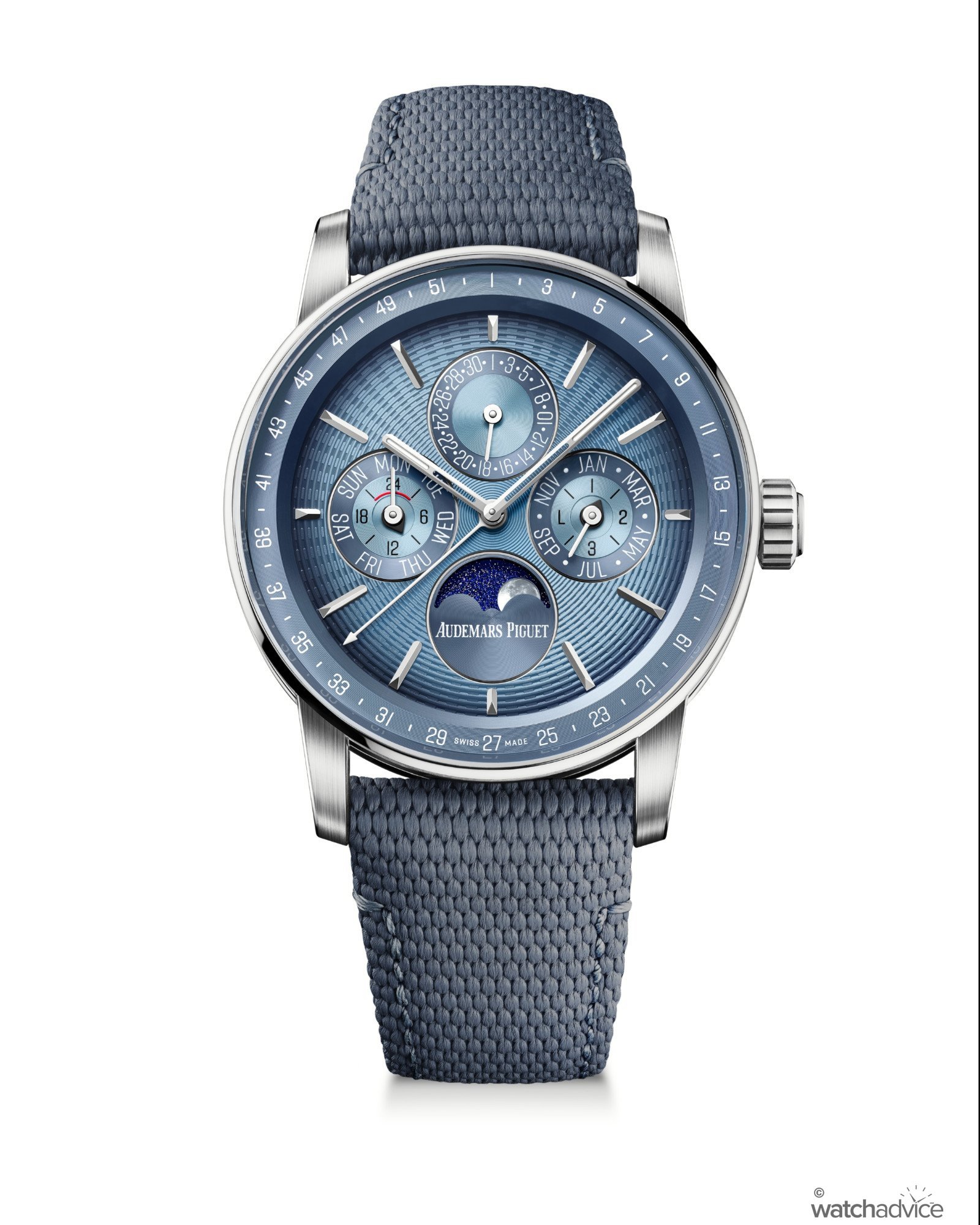

While there aren’t drastic changes on the surface of these timepieces, it’s what lies underneath that has everyone talking. With the introduction of these latest perpetual calendar models comes Audemars Piguet’s newest perpetual calendar movement. The Cal. 7138 is not only innovative, but it also keeps Audemars Piguet’s signature perpetual calendar design intact. No better time than the brand’s 150th anniversary to release a groundbreaking movement.
The introduction of the Calibre 7138, however, means that Audemars Piguet’s current perpetual calendar movements will become obsolete. The current Calibre 5134 will stop production to make way for the new movement. This also means that Calibre 5135, the skeletonised ultra-thin movement introduced in 2019, based on Calibre 5134, will also become obsolete. However, Audemars Piguet wouldn’t simply let Calibre 5135 quietly fade into the night. The last hurrah of this movement comes with the introduction of the Royal Oak Perpetual Calendar 150th Anniversary Limited Edition. Also known as the Audemars Piguet Royal Oak Openworked model, this is easily one of my favourite watches from the brand (besides the Grand Complication, of course, but that is a different beast entirely).


So what makes the Audemars Piguet Royal Oak Pereptual Calendar Openworked so special? I mean, on the surface, it just looks like a skeletonised version of the brand’s perpetual calendar, right? Simply put, the intricate skeletonisation of the dial brings forth enhanced artistry, increased technical complexity, a showcase of Audemars Piguet’s craftmanship and a pure appreciation of the high complexity behind a perpetual calendar movement. What I love about this timepiece is that Audemars Piguet has not lost the functionality of the watch with the skeletonised background. All the sub-dials are easy on the eye, while the artistry of showing the complex movement underneath is still visible for all to see. This intricate dance is indeed rare, as many watch brands forgo functionality for the aesthetic appearance of the skeletonised movement.
Royal Oak Perpetual Calendar “150th Anniversary” Design
Audemars Piguet presents this latest Royal Oak Perpetual Calendar “150th Anniversary” Limited Edition on a 41mm titanium case (mixed with BMG), and thanks to the ultra-thin movement, the case only measures 9.9mm thick! As expected, the case features the exemplary finishing that Royal Oaks are renowned for, with a mixture of brushed and polished finishing that allows the watch to play with light beautifully.


Audemars Piguet has only used this case material a few times before, on their one-of-a-kind Royal Oak “Jumbo” Extra-Thin (Ref. 15202XT), created for OnlyWatch 2021, their Ref. 16202 XT models and the Royal Oak Perpetual Calendar model in 2024. Audemars Piguet states that BMD, or Bulk Metallic Glass, is composed of 50% palladium, which makes it highly resistant to wear and corrosion and has a glossy lustre. This material, in combination with titanium, has been used on the bezel, caseback frame and bracelet studs, which have been mirror polished to give a beautiful wavering glow (adding to the already stunning shine that the Royal Oak has!).

Previous versions of the Royal Oak Perpetual Calendar Openworked include the all black ceramic model, the model in 18k yellow gold and the latest collaboration with Travis Scott’s brand and record label: the Royal Oak Perpetual Calendar Openworked “Cactus Jack”. While these models were certainly stunning creations, this 150th anniversary for me takes the cake.
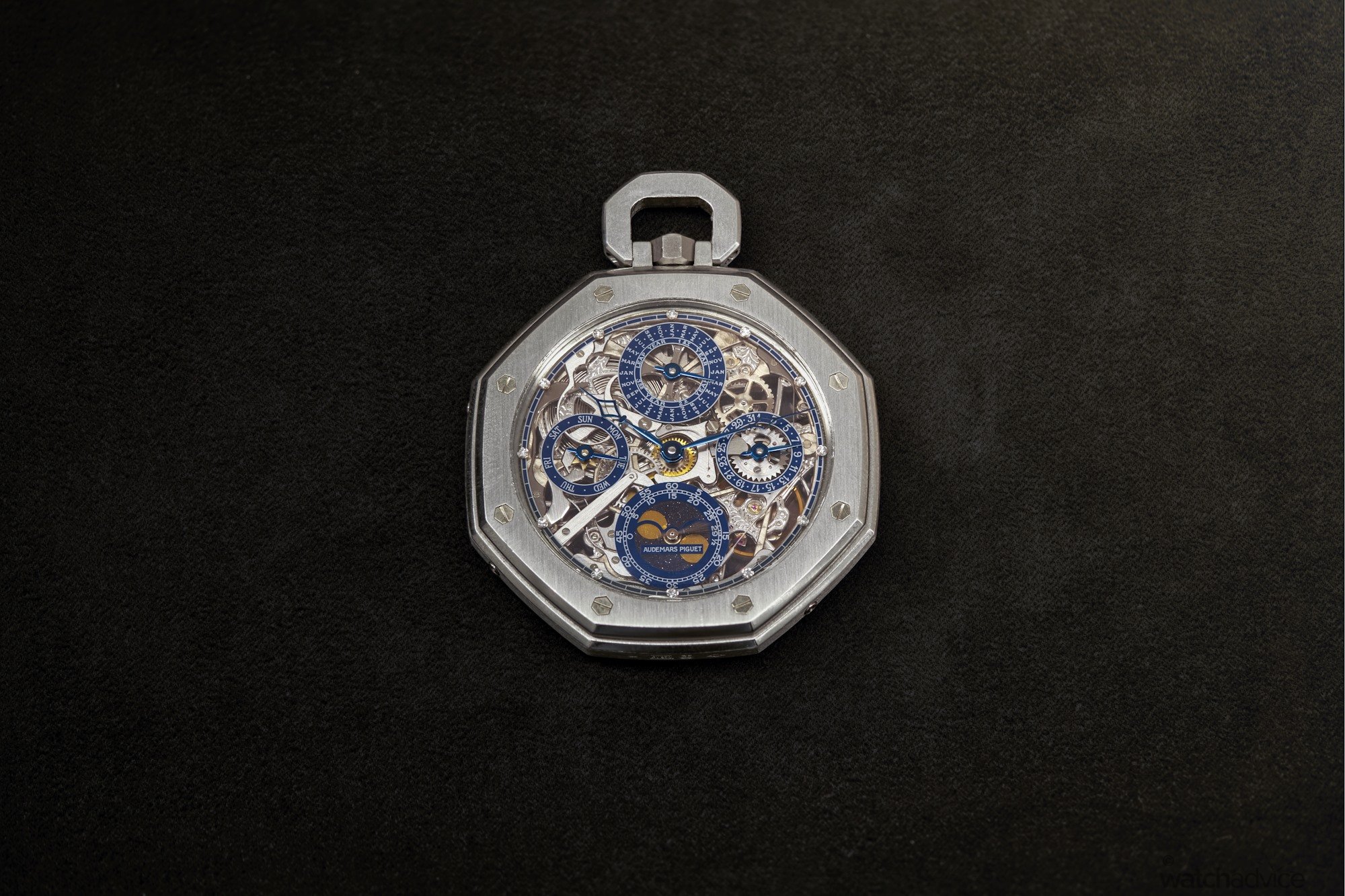
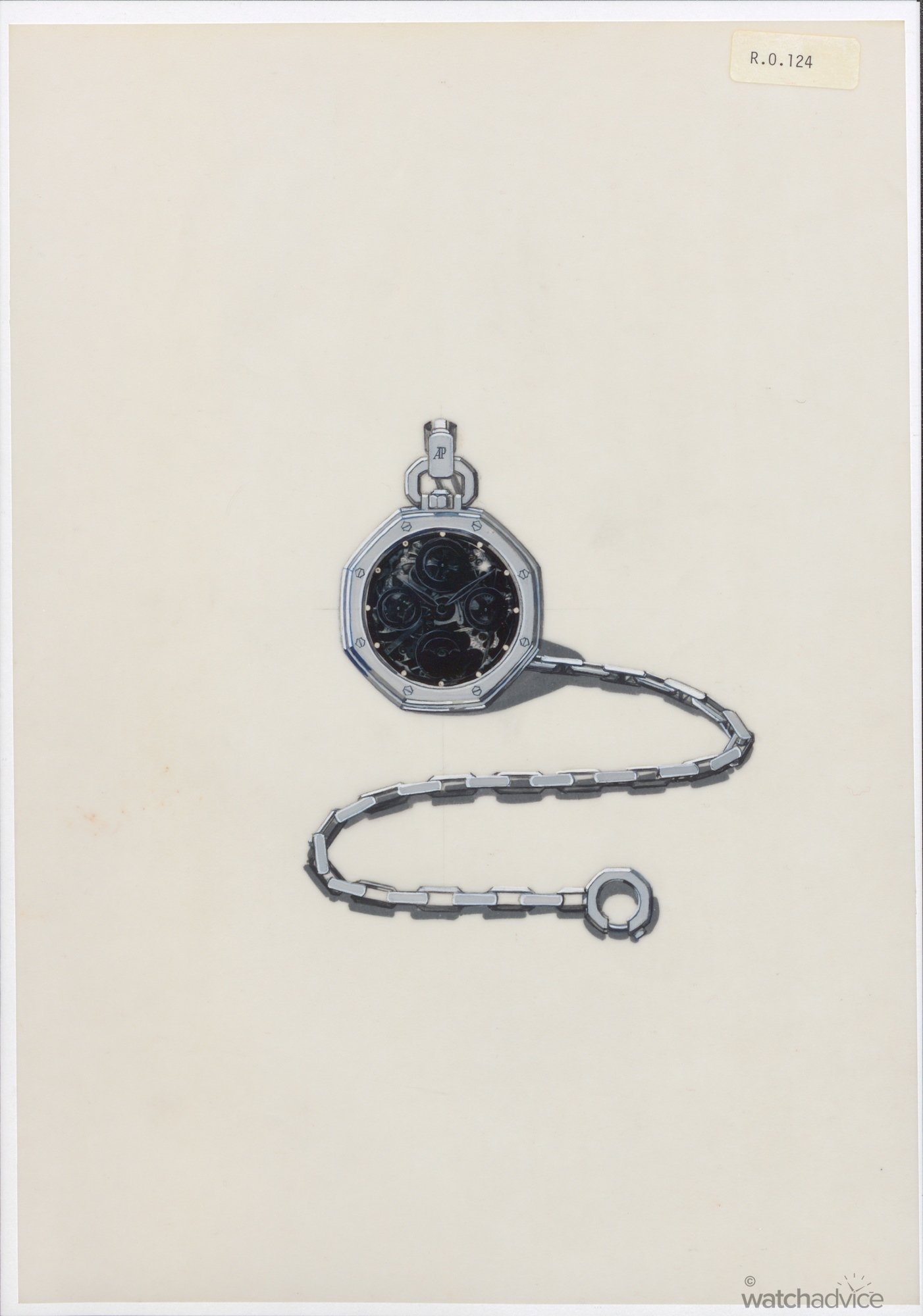
The open-worked dial of this model will be different because it was created for two momentous occasions: the brand’s 150th anniversary and the closing of the chapter on the Calibre 5135 movement. To create this unique openworked model, Audemars Piguet looked to one of their early pocket watch designs, a pocket watch (reference 25729) that is displayed in Musee Atelier Audemars Piguet. This pocket watch was also openworked with perpetual calendar complication, the perfect inspiration for this grand finale of Calibre 5135.
Fitted underneath the new sapphire dial is the openworked design which closely follows the pocket watch reference 25729. Firstly, we have the inner bezel done in a beautiful blue hue, with the date inscriptions done in white to allow for the perfect contrast that also looks aesthetically pleasing to the eye! This is the central colour theme displayed throughout the openworked dial, in line with the pocket watch reference 25729.

The two most notable features on the dial for me is the moon phase indicator and the leap year indicator. Firstly the moon phase indicator at 6 o’clock offers a different perspective compared to the previous version of this timepiece as the phases of the lunar cycle are displayed on the dial by means of a disc decorated with a photographic representation of the Moon as seen from Earth. The brand states that “Based on a NASA photograph, this realistic image has been transferred onto the moon phase disc using metallisation on sapphire, paying tribute to the beauty of the celestial body. As it engages with the movement’s mechanisms, the aperture on the dial presents the eight different phases of the 29.5-day lunar cycle, a soon from both sides of the equator” . The Audemars Piguet signature on the moonphase display is also inspired by historical documents.
The second feature is the leap year indication on the month sub-counter at 12 o’clock. Previously, we have seen the leap year indicated through 1,2,3 and 4 numbers; however, for this 150th anniversary model, Audemars Piguet have gone the extra length by having the inscriptions “1st Year”, “2nd Year”, “3rd Year” and “Leap Year”. This is in line with Pocket Watch reference 25729’s design.
Calibre 5135 Movement
Calibre 5135 was released four years after 5134’s introduction in 2015. The movement combined the ancient art of openworking with now-cutting-edge technology. The first Calibre 5135 movement powered the Royal Oak Perpetual Calendar Openworked in black ceramic (ref. 26585CE), with the timepiece revealing the movement’s refined decorations from the front and case back.
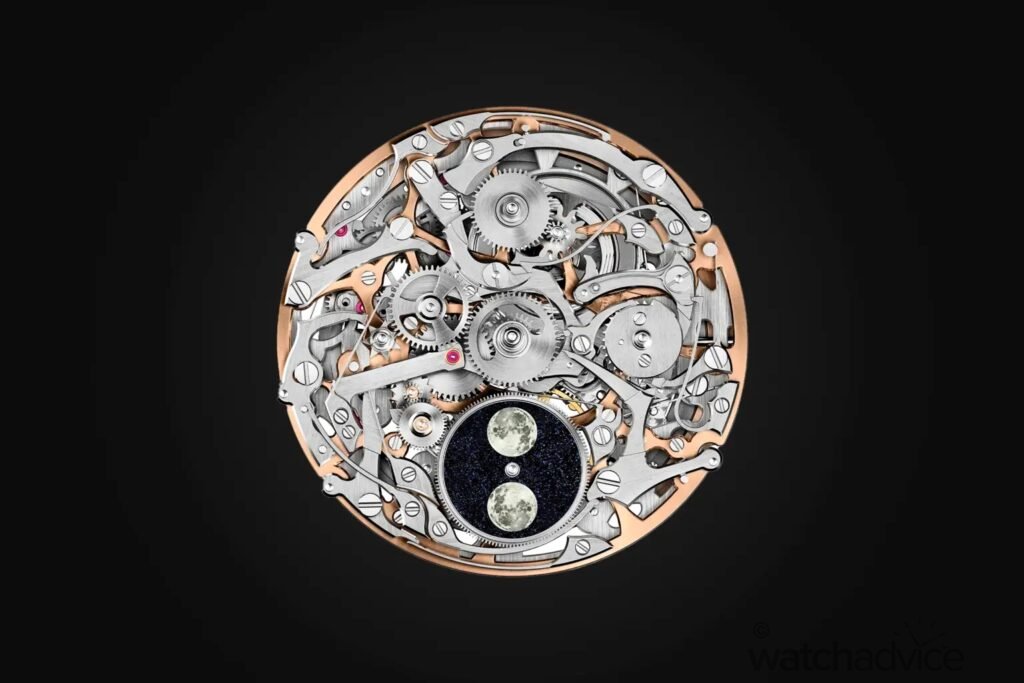
The movement measures 4.5mm thick, which, considering that it houses a perpetual calendar complication, is no small feat. Totalling 374 parts, the Calibre 5135 movement is able to power the perpetual calendar indications of date (3 o’clock sub-counter), moonphase indicator (6 o’clock sub-counter), day of the week indicator (9 o’clock sub-counter) and month and leap year indicator (12 o’clock sub-counter). The movement also displays a week indicator on the inner bezel, which is shown through a separate hand.

As with most perpetual calendar movements that are in line with the Gregorian calendar, the Calibre 5135 won’t need to be adjusted until 2100 as it automatically takes into account the number of days in the month and correctly displays the prevailing date even through the leap years.
Final Thoughts
The Royal Oak Perpetual Calendar 150th Anniversary Edition is more than just a commemorative timepiece—it represents a defining moment for Audemars Piguet. As the final chapter of the Calibre 5135, this watch not only honors the brand’s 150-year legacy but also showcases the evolution of haute horology. This timepiece serves as a bridge between Audemars Piguet’s storied past and the future of its perpetual calendar complications, setting the stage for what’s to come with the new Calibre 7138.
Personally, this is my favourite Royal Oak Perpetual Calendar Openworked model to date. With the inspiration of the design taken from a historic pocket watch, the brand has undoubtedly shown its ties to its past, all the while presenting a stunning timepiece that ensures that the legacy of the Calibre 5135 will be remembered as one of the brand’s most visually and mechanically captivating movements. For collectors and enthusiasts alike, the Royal Oak Perpetual Calendar Openworked 150th Anniversary Limited Edition marks the end of one era and the dawn of another—ensuring that Audemars Piguet remains at the forefront of fine watchmaking for generations to come.
Specification: 26585XT.OO.1220XT.01
- Dimensions: 41mm x 9.9mm thick
- Case Material: Titanium combined with bezel and case back frame made from Bulk Metallic Glass.
- Dial: Skeletonised dial with blue counters. 18-carat white gold round hour indices and blue bathtub hands (with SuperLumi-Nova).
- Movement: In-house Calibre 5135
- Movement Frequency: 19,800VpH (2.75hZ)
- Movement Power reserve: 40 hours
- Water resistance: 20m
- Crystal: Glareproof sapphire crystal
- Case back: Glareproof sapphire crystal
- Bracelet/Strap: Titanium bracelet links with Bulk Metallic Glass studs and a three-blade titanium folding clasp.




